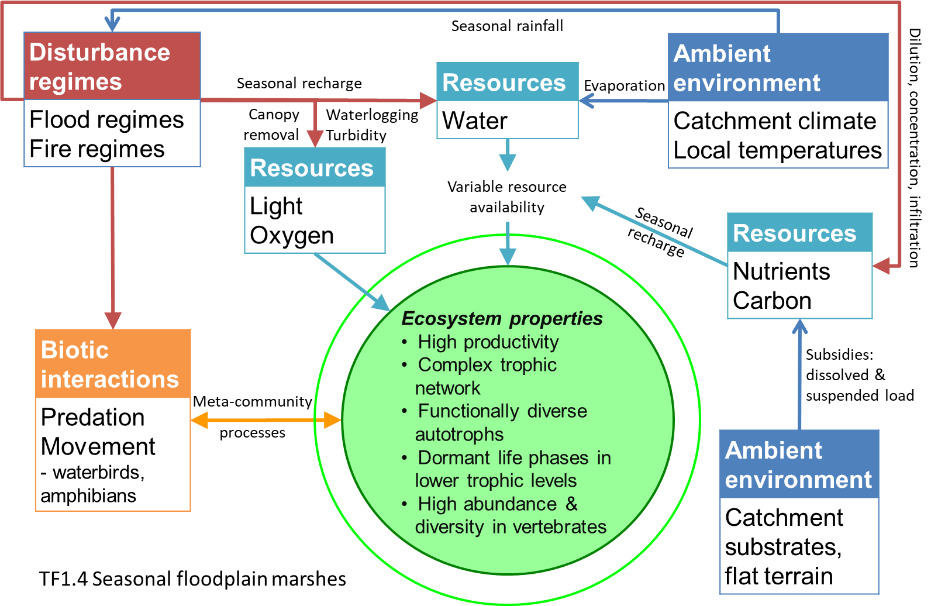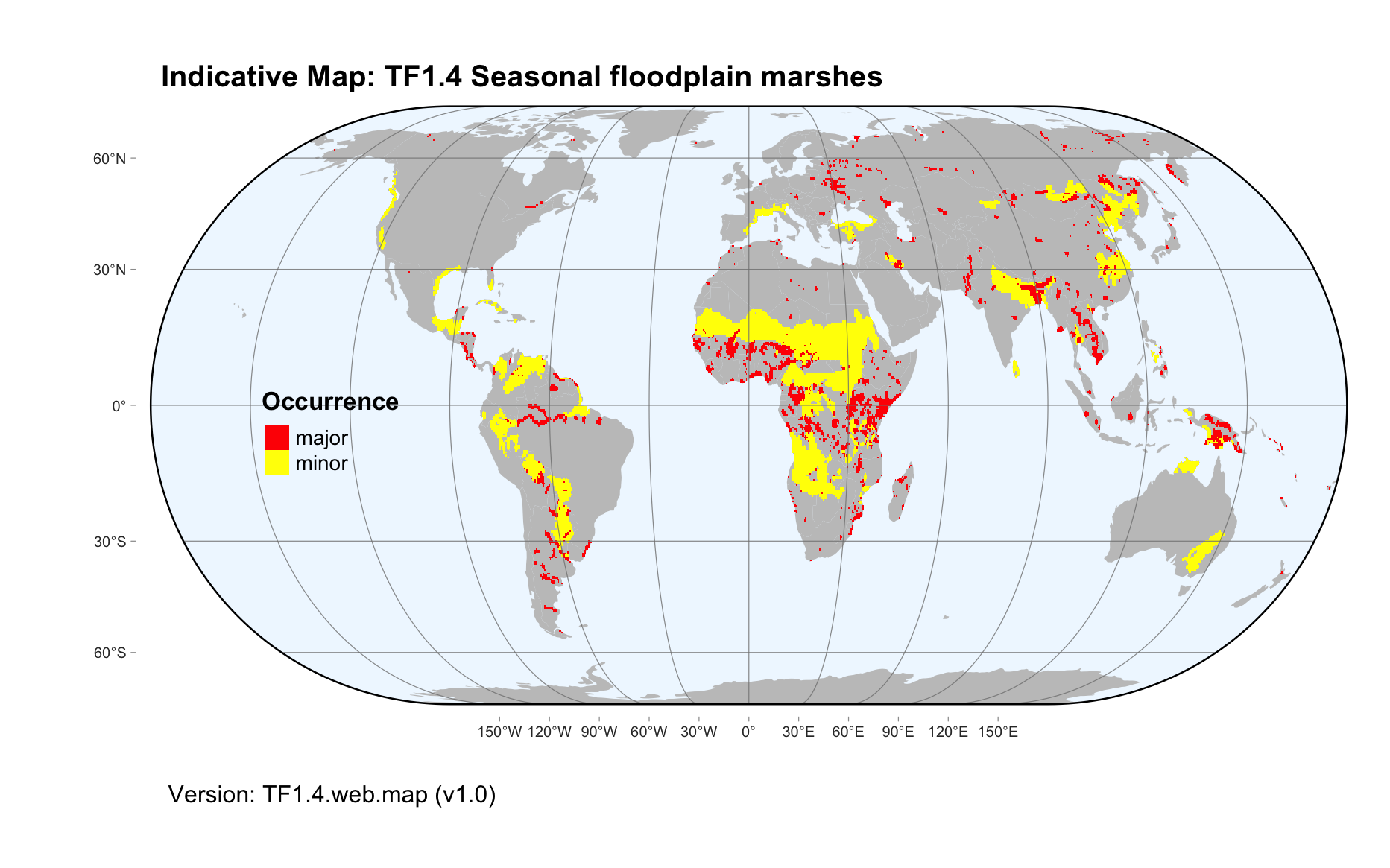Global ecosystem typology
Alternative site for the Global ecosystem typology with additional information for ecosystem profiles and indicative maps.
This site is maintained by jrfep
TF1.4 Seasonal floodplain marshes
Biome: TF1. Palustrine wetlands biome
Contributors:
(texts)
Seasonal flooding and drying regimes characterise high productivity floodplain marshes in the seasonal tropics and subhumid temperate regions. Typically, different plants respond to the mosaic of variable flooding regimes, supporting complex networks of invertebrates, waterbirds, reptiles, and mammals. Prey concentrate as the wetlands dry, and many plants and animals use specialised adaptations such as seed banks or egg banks, to survive drying.
Key Features
High productivity wetlands with strongly seasonal water regimes, supporting functionally diverse mosaics of aquatic plants and seasonally variable trophic networks of invertebrates, amphibians, crocodilians and birds.
Overview of distribution
Seasonal tropics and subhumid temperate regions.
Profile versions
- v1.0 (2020-01-20): DA Keith; RT Kingsford; RC Mac Nally; KM Rodriguez-Clark; A Etter
- v2.0 (2020-06-17): DA Keith; RT Kingsford; R Mac Nally; B Robson; JA Catford; MC Rains; K Irvine; KM Rodriguez-Clark; A Etter
- v2.01 ():
- v2.1 (2022-04-06): DA Keith; RT Kingsford; R Mac Nally; B Robson; JA Catford; MC Rains; K Irvine; KM Rodriguez-Clark; A Etter Full profile available at official site
Main references
Selected references for this functional group:
Damasceno-Junior GA., Semir J, Dos Santos FAM, de Freitas Leitão-Filho H (2005) Structure, distribution of species and inundation in a riparian forest of Rio Paraguai, Pantanal, Brazil Flora-Morphology, Distribution, Functional Ecology of Plants 200:119-135
Diagrammatic assembly model

Maps
Maps are indicative of global distribution patterns are not intended to represent fine-scale patterns. The maps show areas of the world containing major (coloured red) or minor occurrences (coloured yellow) of each ecosystem functional group. See general notes on maps.
There are 2 alternative versions of the indicative map for this functional group, please compare description and sources below.
TF1.4.IM.mix_v1.0
Datasets
- GLWD-2004
- KG-climate-2018
- FEOW-2008
Map references
Lehner, B. and Döll, P. (2004): Development and validation of a global database of lakes, reservoirs and wetlands. Journal of Hydrology 296/1-4: 1-22. Data-set
Beck, H., Zimmermann, N., McVicar, T. et al. (2018) Present and future Köppen-Geiger climate classification maps at 1-km resolution Sci Data 5, 180214 DOI:10.1038/sdata.2018.214
Abell R, Thieme ML, Revenga C, Bryer M, Kottelat M, Bogutskaya N, Coad B, Mandrak N, Contreras Balderas S, Bussing W, Stiassny MLJ, Skelton P, Allen GR, Unmack P, Naseka A, Ng R, Sindorf N, Robertson J, Armijo E, Higgins JV, Heibel TJ, Wikramanayake E, Olson D, López HL, Reis RE, Lundberg JG, Sabaj Pérez MH, Petry P (2008) Freshwater ecoregions of the world: A new map of biogeographic units for freshwater biodiversity conservation, BioScience 58: 403–414. DOI:10.1641/B580507
TF1.4.web.map_v1.0

Datasets
- GLWD-2004
- KG-climate-2018
- FEOW-2008
Map references
Lehner, B. and Döll, P. (2004): Development and validation of a global database of lakes, reservoirs and wetlands. Journal of Hydrology 296/1-4: 1-22. Data-set
Beck, H., Zimmermann, N., McVicar, T. et al. (2018) Present and future Köppen-Geiger climate classification maps at 1-km resolution Sci Data 5, 180214 DOI:10.1038/sdata.2018.214
Abell R, Thieme ML, Revenga C, Bryer M, Kottelat M, Bogutskaya N, Coad B, Mandrak N, Contreras Balderas S, Bussing W, Stiassny MLJ, Skelton P, Allen GR, Unmack P, Naseka A, Ng R, Sindorf N, Robertson J, Armijo E, Higgins JV, Heibel TJ, Wikramanayake E, Olson D, López HL, Reis RE, Lundberg JG, Sabaj Pérez MH, Petry P (2008) Freshwater ecoregions of the world: A new map of biogeographic units for freshwater biodiversity conservation, BioScience 58: 403–414. DOI:10.1641/B580507
Check: the Glossary / Profile structure / the public document